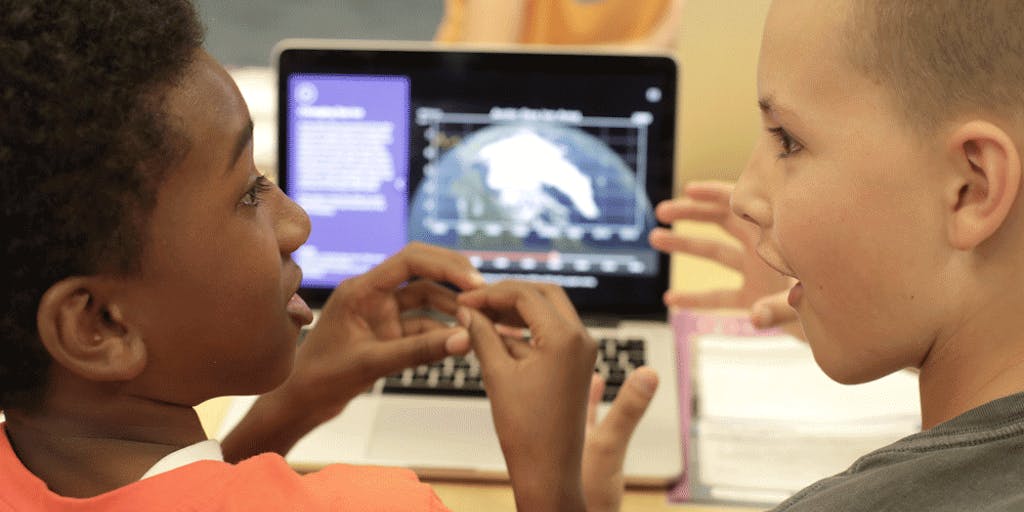On a bright, sunny day, a group of first-graders eagerly begins a science investigation called “Shadow Town.” The teacher gathers them in a circle and asks, “What causes shadows?” It’s a good question. The students are all familiar with shadows, have had fun with them and no doubt played shadow puppets, but that’s different from being able to explain them. Many suggestions are shouted out as students’ imaginations get fired up by the mystery of light and darkness.
The teacher takes the students outside to test their ideas. “Can I run away from my shadow?” one student wonders. Another asks, “Can I trick my shadow into disappearing?” As they experiment with shadows, predict their movements, explore how light interacts with different materials, and discuss what they see with their partners, the students learn not just about the mechanics of shadows but also about the scientific process of inquiry and investigation. Through this exploration, they begin to apply their newfound knowledge to solve a real-world problem: why the town of Rjukan, Norway, spends much of the year in shadow and how different solutions could work.
“Shadow Town,” a module in the K-8 curriculum Twig Science, is an example of phenomena-based learning in action, an approach that taps into students’ natural curiosity to make sense of the world around them. In this context, phenomena are simply observable events or situations. They play a crucial role in science education because they provide students with concrete, engaging examples of scientific concepts in the real world. They provide great opportunities to develop student inquiry — students see something happening, ask questions about it and conduct research to learn more about it.
Image credit: Imagine Learning
Phenomena in the Context of 3D Science
Phenomena-based learning also aligns with the Next Generation Science Standards (NGSS) and other three-dimensional (3D) science standards that emphasize a comprehensive, integrated understanding of science. These standards were designed to move science education away from rote memorization and toward engaging students in practices real scientists use to explore and model the world, fostering deeper understanding of scientific concepts and developing skills like critical thinking, collaboration and communication.
The NGSS and other 3D science standards are structured around three dimensions of science learning:
- Science and Engineering Practices (SEPs): These involve the skills and behaviors that scientists and engineers engage in, such as asking questions, developing and using models, planning and carrying out investigations, analyzing and interpreting data, and constructing explanations.
- Crosscutting Concepts (CCCs): These overarching concepts bridge disciplinary boundaries, such as patterns, cause and effect, energy and matter, structure and function, and stability and change.
- Disciplinary Core Ideas (DCIs): These are fundamental ideas in science that students should understand, divided into four domains — physical sciences, life sciences, Earth and space sciences, and engineering, technology and applications of science.
The integration of these three dimensions helps students develop a holistic understanding of science, moving beyond memorizing isolated facts to actively engaging in scientific practices and understanding the broader concepts that connect different areas of science.
A Motivation to Engage
Phenomena-based learning and 3D science standards naturally complement each other. Phenomena-based learning provides the context and motivation for students to engage in the practices, concepts and core ideas outlined in the standards. For example, in investigating “Shadow Town,” students engage in Science and Engineering Practices by asking questions and planning investigations to understand why shadows change. They use the Crosscutting Concept of “patterns” to observe how shadows behave at different times of the day and the Disciplinary Core Idea of Earth’s movements to explain these patterns. Through this process, they’re not just learning scientific facts but experiencing science as a dynamic, integrated discipline that helps them make sense of the world.

Image credit: Imagine Learning
Creating opportunities for such investigations requires thoughtful design and alignment with educational standards. In designing high-quality instructional materials and even entire curricula that support phenomena-based learning, several key areas demand attention:
- Rich, real-world phenomena: Across grades K-8, effective curricula feature carefully chosen phenomena — such as the passing of the seasons, light reflecting in a mirror or the erosion of mountains — that are relevant, observable and meaningful to students. They’re complex enough to require students to engage deeply with the dimensions of science but accessible enough to be explored through student-led inquiry and investigation.
- High-quality multimedia resources: Videos, interactive simulations and virtual labs bring phenomena to life that students might not otherwise have access to, providing dynamic, visual experiences that enhance understanding.
- Engaging and clear learning materials: Learning materials should be engaging and aligned to 3D science standards. They should guide students through the inquiry process, provide opportunities for reflection and discussion, and scaffold learning to include all students in investigations.
- An innovative assessment system: Assessment systems should help teachers evaluate student understanding of the three dimensions of the NGSS. These systems include a range of assessment strategies, from pre-exploration activities that gauge prior knowledge to formative and summative tasks, plus built-in data-reporting tools to help track student progress throughout their learning journeys.
Combining phenomena-based learning with 3D science standards helps students see science as a way to make sense of the world around them. They become more motivated to learn and more capable of thinking critically about the challenges they will face in the future. As students engage with real-world phenomena, they not only learn about science but also begin to think and act like scientists, developing a lifelong sense of wonder and inquiry that will help them deal with all kinds of challenges they will face throughout their lives, in education and beyond.
